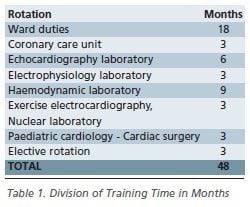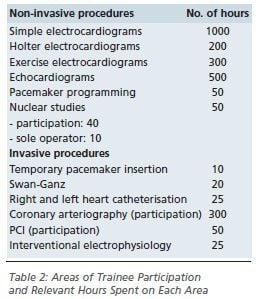HealthManagement, Volume 2 - Issue 1, Spring 2008
Cardiovascular diseases, as the primary cause of mortality and morbidity, have increasingly necessitated the expansion and development of new methods of cardiovascular care. Moreover, practical skills have evolved dramatically in three new areas; echocardiography, electrophysiology and interventional cardiology. Thus, the modern cardiologist is faced with a great expanse of theoretical knowledge in which he has to become an expert.
In Greece, as in most European countries, four years of cardiological training follow two years of training in internal medicine. The training programme during the four years in cardiology follows the requirements of the Chapter on Training of Medical Specialists in the European Union and has been endorsed since 1990 by the Hellenic Society of Cardiology. Thus the training time is allocated as outlined in Table 1 (see below).
It should be noted that the number of trainees per programme corresponds roughly to one resident/fellow per four department beds. This may not be practical for many departments, which for the same number of patient beds have more active laboratories and intensive care units. Accordingly, modifications to address these issues are currently being implemented.
Under the conditions described and again according to the European specifications, every trainee by the time of completion of his training should have acquired experience by performing and interpreting the examinations or procedures outlined in Table 2 (see below).

The trainee should participate in the study, review, and discussion of all these procedures although not all hospitals can afford these facilities.
According to a survey conducted in 2003 by Dr. Evangelos Papasteriadis, former President of the Hellenic Cardiological Society: “Approximately 92 hospitals in Greece provide at least one year of accredited cardiology training, while 41 offer full training. Among those, not all offer full haemodynamic and or electrophysiological laboratory facilities. Residents training in these hospitals rotate in other departments to complement their training”.
Ideally, fellows should keep log-books in which they record their participation in various procedures and the grading through their rotations.
Trainee Log-Book from Onassis Cardiac Surgery Centre
The log-book system has been implemented in our centre since 1993, in which the following activities are recorded over four years.Education
- Previous training centres;
- In-hospital education such as lessons/seminars/presentations (60% attendance compulsory), and
- Extramural education such as courses, seminars, congresses, etc.
- Wards;
- Outpatient clinics;
- Coronary care unit;
- Echocardiography laboratory – studies recorded;
- Haemodynamic laboratory – interventions recorded;
- Electrophysiology laboratory – interventions recorded;
- Exercise, and
- Nuclear laboratories. Scientific Activities
- Presentations and attendance levels at in-hospital courses, seminars and congresses;
- Publications in Hellenic and international scientific journals, and
- Participation in multicentre trials.
Also, the US Accreditation Council for Graduate Medical Education (ACGME) has offered the following specifications for the teaching faculty of hospitals of accredited training and teaching hospitals. There should be at least four instructors in programmes with more than six trainees. They should devote 20 hours per week to teaching, research, administration and resident evaluation.
Additional Training Activities
Apart from the training provided by each individual hospital, efforts have been made to offer formal teaching courses in the form of the ‘Board Review Course’ as modeled by the US, to a number of trainees. Our department thus instituted two three-day seminars per year from 1997 until 2003 and the Hellenic Cardiological Society instituted a year long series of courses since 2003, during the presidency of Prof. Harisios Boudoulas. These courses have proven very successful.Evaluation of Trainees
Each individual hospital offers various ways of evaluating their trainees. Most consist of written examinations every six or 12 months.At the completion of their training, all residents/fellows have to pass state examinations to become licensed as practicing cardiologists. These examinations have evolved over many years. In their current form in the Athens/Piraeus area, the format is that introduced by the author as Chairman of the State Examination Committee in the years 2004 and 2005.
First Day
- Written examinations;
- 10 questions requiring detailed review and discussion;
- 20 multiple choice questions, and
- 10 spot-diagnostic tests, including ECGs, echocardiograms, cineangiograms, etc.
Second Day
Each candidate is assigned to study one patient for about two hours and then is examined by the committee, which consists of a Senior Professor of Cardiology in the University of Athens and two Department of Cardiology Directors from Hospital in the Athens/Piraeus vicinity.
Here some problems and weaknesses of the cardiology training programmes in Greece should be reviewed:
a. The main problem is the long waiting time to enter an accredited training programme, which can stretch to up to seven years. Thus, many candidates have to do with their second or third choice programmes or go abroad to start training.
b. The lack of homogeneity among programmes, some being of much higher quality than others. As already stated, not all hospitals offer full training programmes.
An effort has been made over the last few years to remedy these problems by the following approaches:
i. To offer to smaller or district hospitals the opportunity to form associations with larger hospitals; thus the residents can carry out their clinical training in the first group of hospitals and continue their training in the second.
ii. By modifying the one resident/4 patient bed ratio for hospitals offering a very large range of interventions, both haemodynamic and in electrophysiology.
Continuing Medical Education
This aspect has not been as formally organised in Greece as hospital training. The one formal state-accredited sub-specialty training is in echocardiography, where approved hospitals offer six months of training, after which the trainee undergoes state examinations to become certified in echocardiography.
There have been many efforts to recognise interventional cardiology as a one year subspecialty training, but this has not been approved anywhere in Europe. However, many hospitals offer training in this subspecialty, as well as in invasive electrophysiology. This type of training is unofficially recognised as an asset, mostly in private hospitals.
There is no formal recognised training course leading to a diploma for the private, practicing cardiologist. However, most meetings, seminars, and congresses offer points for continuing education, through a state-Hellenic point system, the European EBAC and the American Continuing Medical Education (CME) systems.
Altogether, cardiology is one of the medical specialties in Greece which offers a training programme of quite satisfactory quality.
Every effort should be made to improve standards, both as regards hospital training but especially so in the field of continuing education.






